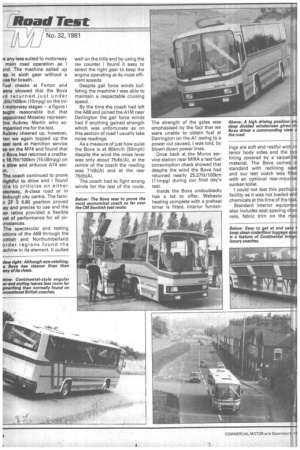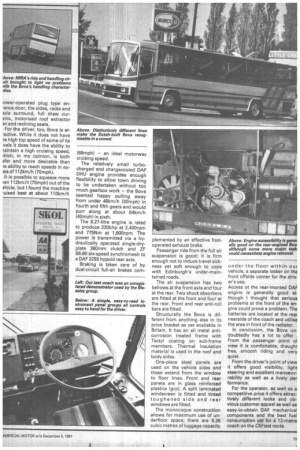Bova puts on a lively show
Page 53

Page 54

Page 55

If you've noticed an error in this article please click here to report it so we can fix it.
Noel Millier test drives the rear-engined Bova luxury coach on the tough CM Scottish circuit and makes some interesting discoveries
HE ESTABLISHED format for a lritish luxury coach has for riany years been mid-engined with a separate chassis and .ody. The concept has been hallenged by rear-engined interals before but never as conviningly as by the Dutch Bova.
Introduced earlier this year to ritish operators by the Moseley iroup, the competitively priced ehicle has proved an immedite success with operators both irge and small, To find out what ley have seen in the vehicle I )ok an example around the CM cottish road test route.
As with all CM full road tests I rst took the fully laden coach to le MIRA test track at Nuneaton 'here I carried out our usual rogramme of performance and raking tests away from the angers of the public road.
The ride and handling circuit ith its reverse cambers and mulated tramlines and level 'ossings brought to light no uirks in the rear-engined )ach's handling characteristics rid the Bova proved both -edictable and comfortable. Emergency full stop brake sts at 32km/h (20mph), 48km/h Ornph) and 64km/h (40mph) towed the coach capable of opping quickly and in a raight line although the rear fside wheel did lock on a iuple of occasions.
The Bova did everything that can be reasonably asked of a 12metre (40ft) coach at MIRA. Acceleration tests showed the machine to be as spritely as necessary and our hill tests showed that, despite coming from the flat lands of Holland the Bova would restart on Porlock Hill if required — the handbrake held and the coach restarted on the 1 in 4 test hill.
On leaving MIRA and starting up the AS I began to like the Bova more and more. The coach cruised at an almost noiseless 80km/h (50mph) with the engine turning over at about 1,800 rpm.
On to the M6 motorway and I prepared myself for any wander from the steering of the rear-engined coach. I suspected that there would be some problem as rear-engined coaches sometimes have a tendency to steer from the rear, but I found no such problem with the Bova which seemed as stable as many mid-engined vehicles I have driven.
The high driving position proved comfortable and gave me a commanding view of the road in front. The simple but efficient dash board gave me all the information I needed without having to take my eyes from the road.
The deep windscreen gave me a particularly wide field c vision. The steering I found to b light enough for relaxed drivin yet firm enough to allow relaxe high-speed motorway driving.
The Bova cruised at just uncle the motorway maximum spee and was capable of the sam speed both uphill and down hil From the time I joined the M the only times I needed t change gear were when traffi conditions dictated a lowe speed. Geographical condition seemed to have no impact o the vehicles performance.
After leaving the motorway quickly became even more ap preciative of the vehicle's hand ling characteristics and founi the turning circle and the visibil ity combined to make parking ii the car park at Kendal's Wool pack Hotel far less of a probierr than it could have been witt other 12-metre (40f1) coaches.
Getting out of the Woolpacl car park proved as easy as get ting in and it was back to the road North. I found the taperec front end styling of the Bova great boon to manoeuvering ir tight spots which makes thE coach particularly well suited tc big city operation.
This did not mean the Bova is any less suited to motorway main road operation as I Jrid. The machine sailed up ap in sixth gear without a use for breath.
Fuel checks at Forton and etna showed that the Bova id returned just under .21it/100km (10mpg) on the iniI motorway stages — a figure I Dught reasonable but that 3appointed Moseley represen:lye Aubrey Martin who acmpanied me for the test.
Aubrey cheered up, however, len we again topped up the asel tank at Hamilton service ea on the M74 and found that ir Bova had returned a credita
18.71it/100km (15.08mpg) on e slow and arduous A74 seem.
The coach continued to prove )lightful to drive and I found ttle to criticise on either otorway, A-class road or in linburgh city centre. The famiir ZF S 6.80 gearbox proved isy and precise to use and the 3ar ratios provided a flexible vet of performance for all cirimstances.
The spectacular and testing :ctions of the A68 through the :offish and Northumberland order regions found the lachine in its element. It pulled well on the hills and by using the rev counter I found it easy to select the right gear to keep the engine operating at its most efficient speeds.
Despite gall force winds buffeting the machine I was able to maintain a respectable cruising speed.
By the time the coach had left the A68 and joined the AIM near Darlington the gail force winds had if anything gained strength which was unfortunate as on this section of road I usually take noise readings.
As a measure of just how quiet the Bova is at 80km/h (50mph) despite the wind the noise level was only about 75db(A), at the centre of the coach the reading was 71db(A) and at the rear 75db(A).
The coach had to fight strong winds for the rest of the route. The strength of the gales was emphasised by the fact that we were unable to obtain fuel at Darrington on the Al owing to a power cut caused, I was told, by blown down power lines.
Once back at the Murco service station near MIRA a last fuel consumption check showed that despite the wind the Bova had returned nearly 25.271it/100km (11mpg) during our final day's test.
Inside the Bova undoubtedly has a lot to offer. Webasto heating complete with a preheat timer is fitted. Interior furnish
ings are soft and restful with in tenor body sides and the roo lining covered by a carpet-likt material. The Bova comes a: standard with reclining seat: and our test. coach was fittec with an optional rear-mountec sunken toilet.
I could not test this particula facility as it was not loaded witl chemicals at the time of the test.
Standard interior equipmen also includes seat spacing chan nels, fabric trim on the mail
,ower-operated plug type en-ance door, the sides, racks and 3cia surround, full draw curins, motorised roof extractor 3n and reclining seats.
For the driver, too, Bova is at-active. While it does not have -le high top speed of some of its vals it does have the ability to laintain a high cruising speed, thich, in my opinion, is both afer and more desirable than le ability to reach speeds in exms of 112km/h (70mph).
It is possible to squeeze more ian 112km/h (70mph) out of the 3hicle, but I found the machine -uised best at about 110km/h
(68mph) — an ideal motorway cruising speed.
The relatively small turbocharged and chargecooled DAF DHU engine provides enough flexibility to allow town driving to be undertaken without too much-gearbox work — the Bova seemed happy pulling away from under 48km/h (30mph) in fourth and fifth gears and would purr along at about 64km/h (40mph) in sixth.
The 8.27-litre engine is rated to produce 230bhp at 2,400rpm and 775Nm at 1,600rpm. The power is transmitted via a hydraulically operated single-dryplate 380mm clutch and ZF S6.80 six-speed synchromesh to a DAF 2255 hypoid rear axle.
Braking is taken care of by dual-circuit full-air brakes corn plemented by an effective footoperated exhaust brake.
Passenger ride from the full air suspension is good; it is firm enough not to induce travel sickness yet soft enough to cope with Edinburgh's under-maintained roads.
The air suspension has two bellows at the front axle and four at the rear. Two shock absorbers are fitted at the front and four at the rear. Front and rear anti-roll bars are fitted.
Structurally the Bova is different from anything else in its price bracket as yet available in Britain. It has an all metal anticorrosion treated frame with Tectyl coating on sub-frame members. Thermal insulation material is used in the roof and body sides.
One-piece steel panels are used on the vehicle sides and these extend from the window to floor lines. Front and rear panels are in glass reinforced plastics (grp). A split laminated windscreen is fitted and tinted toughened side and rear windows are fitted.
The monocoque construction allows for maximum use of underfloor space, there are 6.26 cubic metres of luggage capacity under the floor within out vehicle, a separate locker on the front offside corner for the driver's use.
Access ot the rear-monted DAF engine is generally good although I thought that serious problems at the front of the engine could prove a problem. The batteries are located at the rear nearside of the coach and utilise the area in front of the radiator.
In conclusion, the Bova undoubtedly has a lot to offer . From the passenger point of view it is comfortable, draught free, smooth riding and very quiet.
From the driver's point of view it offers good visibility, light steering and excellent manoeuvrability as well as a lively per formance.
For the operator, as well as a competitive price it offers attractively different looks and obvious customer appeal as well as easy-to-obtain OAF mechanical components and the best fuel consumption yet for a 12-metre coach on the CM test route.


































































